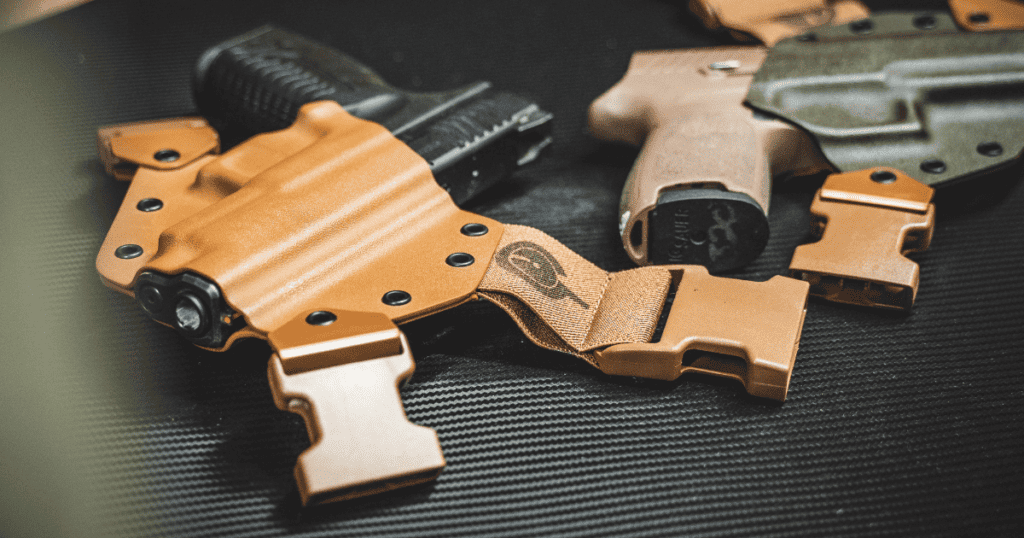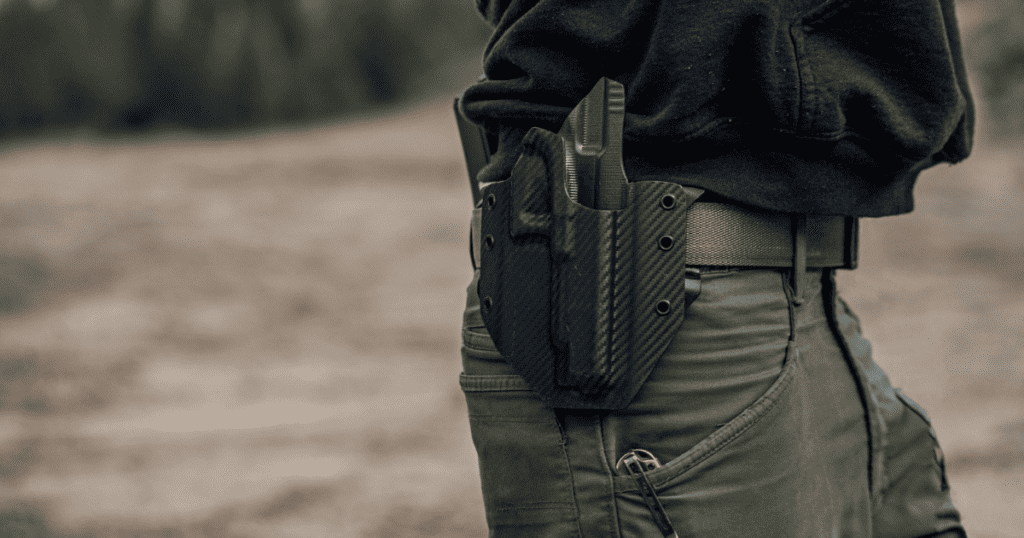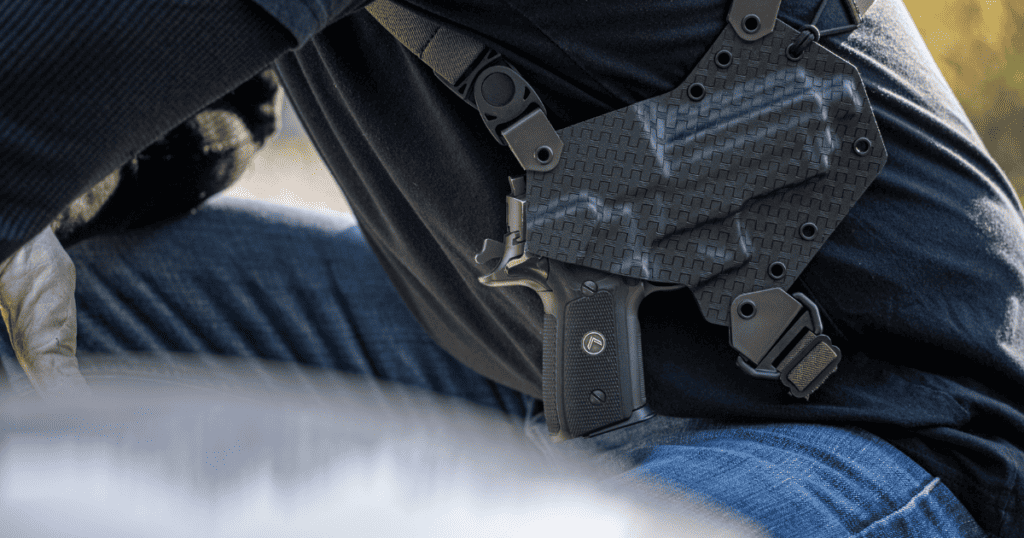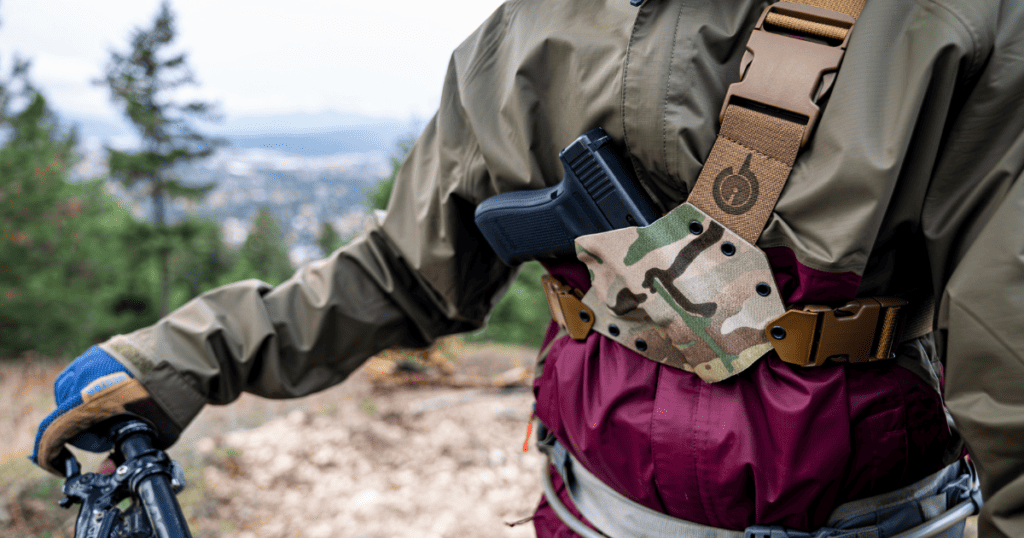A well-chosen holster is much more than an accessory for a shooter. It’s a pivotal component that can impact your overall shooting experience. Whether you are a law enforcement officer, a competitive shooter, or a concealed carry civilian, the right holster can enhance safety, improve access, and offer better comfort.
Transforming Your Shooting
Selecting the right holster isn’t just about carrying your firearm. It’s about changing your entire shooting experience.
Let’s explore several reasons why the ideal holster will elevate how you shoot:
Enhanced comfort and confidence
Comfort can significantly impact your focus and readiness. This makes the right holster choice essential for top shooting performance. A properly fitting holster increases comfort during extended periods of carry and boosts your confidence as a shooter.
Improved accessibility and speed
The right holster allows quick and efficient access to your firearm, reducing the time it takes to draw. This can be critical in defensive situations where every second counts.
Better concealment without sacrificing accessibility
A holster provides the perfect balance between concealment and accessibility by allowing for effective concealed carry without compromising the ease of drawing your firearm.
Safety and retention
Choosing the right holster ensures your firearm remains securely in place during movement and reduces the risk of accidental discharge or loss of your weapon.
Adaptability to various situations
The right holster adapts to different clothing choices, activities, and scenarios, ensuring you can carry your firearm effectively regardless of the situation. This versatility enhances your overall shooting experience by providing you with a holster that is reliable and useful.
Choosing the Right Holster

Having the right holster is an integral part of your shooting experience. So how do you choose the right one for you?
It’s all about understanding your gun and shooting needs – from carrying frequency and comfort to holster type and materials.
Let’s look at each area to help you better understand how to find the perfect holster.
Key considerations for choosing a holster
Firearm size
A good holster should fit your gun snugly to provide secure retention while allowing for a smooth draw. It should cover the trigger guard completely to prevent accidental discharges but not interfere with the gun’s controls.
Lifestyle and carrying frequency
If you’re an active person who spends a lot of time outdoors, you might prefer a rugged, outdoor-friendly holster. On the other hand, if you carry your firearm daily in urban environments, you might opt for a discreet inside-the-waistband (IWB) holster that’s easy to conceal under clothing.
For instance, at GunfightersINC, we have the Kenai Chest Holster that’s great for the outdoors and the Solace Hybrid IWB Holster for everyday carry (EDC).
Personal comfort
Don’t underestimate the importance of comfort. You’re more likely to carry your firearm consistently if your holster is comfortable. Pay attention to the holster’s material, weight, and design.
Some people find leather holsters more comfortable because they conform to the body over time, while others prefer Kydex holsters’ durability and maintenance-free nature.
Different holsters for different situations
Remember, there’s no one-size-fits-all solution for holsters. You might need different holsters for different situations or clothing styles.
For example, you might use a shoulder holster when wearing a suit, a chest holster when hiking, or an OWB (outside-the-waistband) holster for open carry or range use.
Choosing a type of holster
Understanding the advantages and drawbacks of each type of holster can help you decide which one best meets your needs.
Inside the waistband (IWB) holsters

IWB holsters are extremely popular for concealed carry.
- They’re designed to be worn inside your pants, which provides excellent concealment.
- IWB holsters strike a balance between comfort and concealment.
- Depending on the size of the firearm and your body shape, most people can find a comfortable spot to wear the IWB holster.
We offer two IWB holsters – Solace Hybrid IWB Holster and Wraith IWB Holster – to help you find a holster design that works for your carrying needs and comfort.
Outside the waistband (OWB) holsters

OWB holsters are typically attached to your belt and worn outside your pants.
- OWB holsters are often more comfortable and better suited for carrying larger firearms.
- They also provide quick and easy access to your firearm, making them a popular choice for range use and open carry.
- OWB holsters don’t offer the same level of concealment as IWB holsters. However, there are OWB holsters designed for better concealment, like our Ronin OWB Holster.
If you’re stuck between picking an OWB holster or an IWB holster, read IWB vs. OWB Holsters: Which Is Best for You? to help you choose the right one.
Shoulder holsters

Shoulder holsters are an excellent option for those who spend a lot of time sitting or driving.
- They hang from a harness worn over your shoulders, positioning the firearm under your arm for easy access.
- This holster style keeps the weight off your waist, which can be more comfortable for extended periods, like our Spectre Shoulder Holster design.
- Shoulder holsters aren’t easy to conceal and require a jacket or outer garment to conceal it.
Chest holster

Chest holsters are favored by outdoor adventurers and individuals who wear additional gear.
- They’re secured across the chest, making the firearm easily accessible, even with a backpack or seated position.
- This holster type excellently distributes the firearm’s weight to enhance comfort during extended use, as found in our Kenai Chest Holster comfort first design.
- Chest holsters may not be ideal for daily concealed carry, as they require specific attire for concealment.
Read Why You Should Consider a Chest Holster for more information.
Pocket holsters
Pocket holsters are designed for small, lightweight firearms.
- They fit inside your pocket to provide a convenient and discreet carry option.
- Choosing a design that minimizes the risk of your gun snagging during the draw is crucial.
- A good pocket holster should also disguise the outline of the gun to avoid “printing” (when the outline of your pistol can be seen through your clothing).
Belly band holsters
Belly band holsters are a versatile option that can be positioned anywhere around your waist or even higher up on your torso.
- They’re a good choice if you wear clothing without a belt or pockets.
- Some users find them less comfortable over long periods, particularly in warm weather.
Choosing holster material
The most commonly used holster materials are leather, Kydex, and synthetic fabrics like nylon and neoprene. Each of these materials has its own advantages and drawbacks.
For a deeper discussion on these holster materials, read Kydex vs Leather Holsters. But here’s a breakdown of each type of holster material.
Leather
Leather is a traditional material for holster manufacturing, prized for its durability and aesthetic appeal.
- It’s pliable and can conform to the shape of the gun and the wearer’s body over time, increasing comfort.
- Leather requires regular maintenance to prevent drying and cracking, and it may not be the best choice for extreme weather conditions since it can absorb moisture.
Kydex
Kydex is a type of thermoplastic that has gained popularity in recent years. It’s the material we use for all of our holsters at GunfightersINC.
- It’s incredibly durable and resistant to impacts, scratches, and the elements.
- Kydex doesn’t require any special maintenance.
- It retains its shape even when the gun isn’t holstered, which ensures a consistent, reliable draw.
- For some, leather or synthetic fabrics may be more comfortable against the skin.
Synthetic fabrics
Synthetic fabrics like nylon and neoprene balance the rigidity of Kydex and the flexibility of leather.
- They’re lightweight, affordable, and typically require less maintenance than leather.
- Nylon is particularly resilient to environmental factors and can withstand various temperatures and humidity.
- They don’t provide the same level of firearm retention as Kydex or leather and can lack these materials’ premium feel and longevity.
Choosing holster retention

Holster retention is a critical aspect of carrying a firearm. At its most basic, it refers to the ability of a holster to keep the gun securely in place. The level of retention you select will depend on your shooting and carrying needs.
If you’re new to holster retention levels or want a refresher, read Your Definitive Guide to Holster Retention.
Otherwise, here are the different methods used to achieve retention:
Friction
Friction-based retention is the simplest form commonly found in Level 1 holsters. The gun is held in place by the snug fit of the holster around the firearm. This method relies on the tightness of the holster’s fit and the pressure from the wearer’s body.
At GunfightersINC, we believe Level 1 Passive Retention is all you need for your holster as a civilain.
This design ensures the firearm remains securely in place, requiring a deliberate and proper drawing action for release. With our superior hand-set retention – based around the real firearm – you can rest assured your firearm will stay securely in your holster but still draw smoothly should you need it.
While friction offers easy accessibility, it may not provide enough security for those involved in more active or dynamic shooting situations.
Flaps and straps
Flaps and straps add an extra layer of security to the holster. These are typically found in Level 2 holsters and require an additional step to draw the firearm, such as snapping or unsnapping a strap or lifting a flap.
While this increases the security of the firearm, it can also slow down the draw speed.
Trigger guard locks
Trigger guard locks provide high security and are often found in Level 3 and higher holsters. These mechanisms lock the firearm in place until manually released by pressing a button or lever during the draw stroke.
While they offer excellent retention, they require practice to ensure a smooth and quick draw and are typically only used by law enforcement officers.
Why Your Holster Choice Matters

Remember, the right holster isn’t just about the fit for your firearm – it’s about a fit for your shooting and carrying lifestyle.
By taking the time to find the holster that best suits your needs, you secure your firearm and enhance your shooting experience, safety, and comfort.
March 21, 2024
